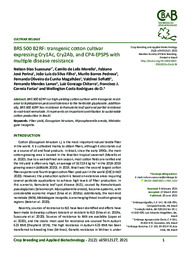BRS 500 B2RF: transgenic cotton cultivar expressing Cry1Ac, Cry2Ab, and CP4-EPSPS with multiple disease resistance.
BRS 500 B2RF: transgenic cotton cultivar expressing Cry1Ac, Cry2Ab, and CP4-EPSPS with multiple disease resistance.
Author(s): SUASSUNA, N. D.; MORELLO, C. de L.; PERINA, F. J.; SILVA FILHO, JOÃO LUIS DA; PEDROSA, M. B.; MAGALHÃES, F. O. DA C.; SOFIATTI, V.; LAMAS, F. M.; CHITARRA, L. G.; FARIAS, F. J. C.; O, W. C. R. do; FARIAS, F. J. C.
Summary: Cotton (Gossypium hirsutum L.) is the most important natural textile fiber in the world. It is cultivated mainly to obtain fibers, although it also stands out as a source of oil and food products. In Brazil, since the early 1990s, the main cotton-growing area is located in the Brazilian tropical savannah (Morello et al. 2020). Due to a well-defined rain season, most cotton fields are rainfed and the lint yield is often very high, an average of 1672.94 kg ha-1 in the 2018-2019 growing season (ABRAPA 2020). In 2019, Brazil was the second largest cotton fiber exporter and fourth largest cotton fiber producer in the world (OECD-FAO 2020). However, the production system is based on extensive areas requiring several pesticide applications to achieve high levels of fiber production. In this scenario, Ramularia leaf spot disease (RLS), caused by Ramulariopsis pseudoglycines (teleomorph: Mycosphaerella areola), became epidemic, with considerable economic impact (Silva et al. 2019a). Additionally, the root-knot nematode (RKN), Meloidogyne incognita, is an emerging threat in cotton-growing regions (Belot et al. 2020). Recently, sources of resistance to RLS have been identified and efforts have been made to develop cultivars tolerant or resistant to RLS (Silva et al. 2019a, Suassuna et al. 2020). Sources of resistance to RKN are available (Lopes et al. 2020), and the stocks most used for resistance are sourced from Auburn 623 RNR (Shepherd 1974). The high resistance in Auburn 623 RNR has been RNR (Shepherd 1974). The high resistance in Auburn 623 RNR has been transferred to breeding lines (M-lines). Genetic resistance in M-lines is under oligogenic inheritance, determined by two QTLs located on chromosomes 11 and 14. The QTL (qMi-C11), located on chromosome 11, has a dominant effect on gall formation, whereas the QTL (qMi-C14), located on chromosome 14, has a partial dominant effect and is associated with reduced egg production (Silva et al. 2019b). Resistance (near-immunity) to the RKN is conferred by an epistatic interaction between the two QTLs (Gutiérrez et al. 2010, Lopes et al. 2020). A cotton-breeding program was established by Embrapa in the 1980s to develop cultivars adapted to the cerrado (Brazilian tropical savanna) environment focusing on high-quality fiber (Morello et al. 2020) or enhanced disease resistance (Suassuna et al. 2020). Here, we report the development of the transgenic cotton cultivar BRS 500 B2RF, with resistance to RLS and partial resistance to RKN, which represents an important genetic contribution to sustainable cotton production in tropical environments.
Publication year: 2021
Types of publication: Journal article
Unit: Embrapa Cotton
Observation
Some of Embrapa's publications are published as ePub files. To read them, use or download one of the following free software options to your computer or mobile device. Android: Google Play Books; IOS: iBooks; Windows and Linux: Calibre.
Access other publications
Access the Agricultural Research Database (BDPA) to consult Embrapa's full library collection and records.
Visit Embrapa Bookstore to purchase books and other publications sold by Embrapa.

